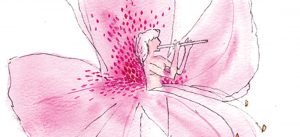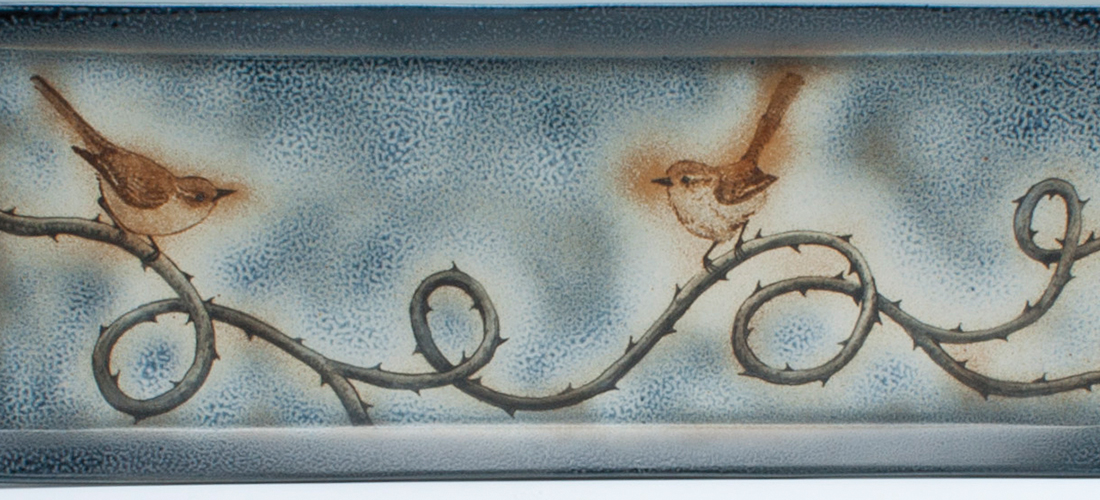
Wild Fired
The animal-inspired pottery of Charlie Tefft
By Maria Johnson
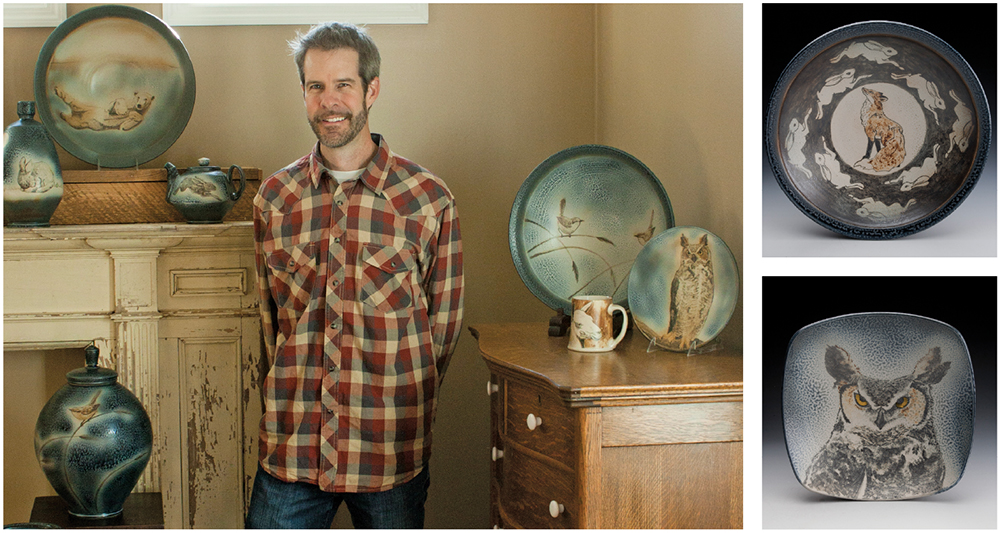
A dozen years ago, Greensboro artist Charlie Tefft thought
he knew what being a successful potter meant.
It meant getting your work in big-city galleries.
It meant schlepping your wares to far-flung weekend
pottery shows.
It meant getting written up in pottery publications such as Ceramics Monthly and Clay Times. (Yes, those are actual, credible publications, not fake ceramic news).
Eventually, all of those benchmark things happened to Tefft, and guess what?
He wasn’t that successful. At least not monetarily.
So, spurred in part by the need to support his growing family, he shifted his thinking and his practices.
He simplified.
He cut expenses.
He came home.
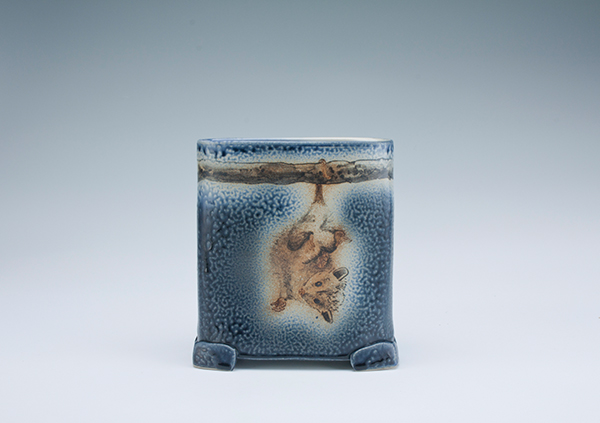
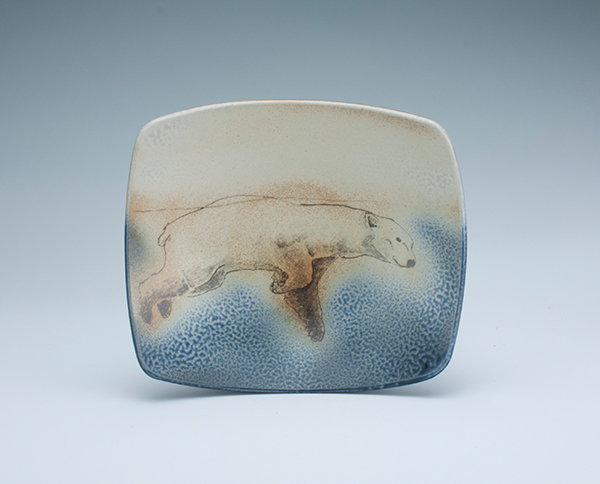
He stopped spending so much time and money on the photography, correspondence and shipping required to land a few pieces in galleries that took
50 percent of his sales and, therefore, made him hike the prices of his work.
He sliced his travel bill by focusing on regional and local pottery shows where he sold directly to customers.
He camped out at the Catawba Valley Pottery & Antiques Festival in Hickory,
He became a regular at the spring and fall craft shows at the Greensboro Farmers Curb Market on Yanceyville Street.
He signed up for Keep It Local, the twice-a-year art show hosted by friend and fellow potter Leanne Pizio at her Oak Ridge studio.
Tefft compiled snail-mail and e-mail lists of people who bought his work, and he notified them about upcoming shows.
His repeat sales climbed.
“How many people are in Greensboro?” he says. “Certainly not all of those people are interested in pottery, but even if 1 percent are interested, that’s a lot of people. . . Doing something that’s not prestigious, but local, that’s what built my business. It wasn’t getting in Ceramics Monthly. It was doing the Farmers Market every spring and fall, and building clientele through that.”
As he waded into a smaller pond, Tefft refined his signature techniques and style, including spray-on glazes, which pool in pockets of deep color. His tones stick close to the earth: tawny browns, creams, blues and grays.
He also perfected the delicate paintings of the wildlife that populate his work. Among his favorite subjects: Carolina wrens, black bears, polar bears, deer, opossums, foxes, owls, rabbits and squirrels.
Tefft — who briefly fancied a career as a veterinarian — paints the critters on his pottery using fine brushes dipped in washes and stains.
“It’s like a watercolor painting,” he says.
There’s a pipeline between what Tefft sees in everyday life and the designs that appear in his work.
The foxes? Inspired by a vulpine neighbor that Tefft unmasked when the animal got its head stuck in a Lay’s potato chip bag.
The black bears? Tefft, his wife and three kids, spotted one on a trip to Skyland Resort in Virginia’s Shenandoah National Park three summers ago.
The squirrels? There are more squirrels than students under the oaks at Guilford College, where Tefft teaches.
The swimming polar bears? Saw them at the North Carolina Zoo
last summer.
The opossums? A friend in wildlife rescue showed Tefft a box of baby opossums at the Farmers Market, and Tefft was so charmed he made her a cup painted with the wee marsupials.
The wrens? They built nests in a shed outside a home where Tefft and his family lived years ago. The pert birds pop up all over his work, not only in image — they often appear perched on grasses and thorny vines — but in form. His wren-shaped pitchers beautifully suggest the birds’ beaks, eyes, breasts, wings and tail.
The pitchers predated the paintings.
“For a long time, I wanted to have animals on the pots, but I couldn’t figure out how to do it,” says Tefft. “That wren pitcher was really satisfying. I felt like I’d tapped into something. It’s just been a long explorations of how to incorporate animals in ceramics.”
His love of ceramics ignited in childhood.
Born in Raleigh, he moved with his family to Columbia, Maryland, outside Washington, D.C., when he was a year old. His father was an early computer consultant. His mother was a gifted watercolorist. Their boy Charlie was drawn to art, too.
“Being dyslexic, reading was hard for me, so I was an art kid,” he says. “That was the place in school where I excelled the most.”
He discovered pottery in a class at his Episcopal elementary school, which led to a clay-themed summer camp, which led to an infatuation with the pottery studio in his Quaker high school.
“I always liked working with my hands,” he says. “We had this creek near our house, and I remember dragging this bucket of clay across a field with a friend of mine to make stuff.”
His bond with earthenware led him to another Quaker school, Guilford College, the home of a ceramics program that was started and nurtured by Lisa Young.
By his junior year, Tefft was basically living in the studio.
“I became a teaching assistant. We were given the keys. The growth during that time was amazing,” he says. “I’d go into the studio and do things I couldn’t do the week before.”
He moved to Atlanta after graduation in 1997, intending to work a day job and throw pots at night. His parents encouraged him to take a slightly different tack: to throw himself into his pots day and night. “They said, ‘We really believe in you,’” he says. “That made all the difference in the world.”
He haunted a cooperative studio and lived on a trickle of income that allowed no TV or cell phone.
He banked experience instead, developing his hallmark eye-hand coordination.
Whatever fascinated his eye, his hands translated to clay. When he saw a photograph of a twirling dancer, her skirt an eddy of fabric, he reincarnated the image as a teapot. A picture of Whirling Teapot was published in a 1998 book, Wheel-Thrown Ceramics by Don Davis.
The picture got Tefft noticed.
A friend rang the following year. There was a temporary teaching position at Guilford College. The job was supposed to last one semester, while Tefft’s former teacher, Lisa Young, was on leave.
“A couple of weeks later, she said, ‘What about two semesters?’ Then it was ‘What about years?’” Tefft remembers. “She left the college and passed it to me.”
That was 18 years ago.
As the college’s only pottery teacher, Tefft leads two classes a semester, which leaves him time to work in his studio, a converted outbuilding in his side yard. He shares the space with apprentice Ray Knirs and another colleague: Tefft’s Australian Shepherd-St. Bernard mix, Walt. Accommodations have been made for Walt’s tail.
“You see there’s nothing wet on the lower shelves because of his hair,” says the 44-year-old Tefft, who looks and acts as you might imagine a potter would.
Lanky, bearded and unpretentious in a T-shirt, work pants and spongy black Crocs, he’s animated by a gentle spirit, but his keen eyes record everything.
He works on pottery daily, often at night after the kids are asleep.
He sweats the details, laboring to make the lips of his tumblers dribble-proof, the spouts of his teapots dripless, the handles of his mugs comfortable to adult fingers.
His pieces work, both functionally and aesthetically, a harmony born of long hours.
“I’m not a production machine,” Tefft says. “I do higher quality work. I touch these pieces a lot.”
But all is not drudgery. Tefft injects his work with humor, too. A plate titled Dreaming Fox shows a wily red veteran pondering rabbits that circle him like clouds. A mug shows a wren perched on the back of a snake that resembles a vine. By depicting animals in moments filled with prey-predator tension, Tefft makes them characters, not just decorations, and implies their lives beyond pottery.
“I feel like I’m capturing them in a small part of their world,” he says. “That’s the art side versus the merely craft side.”
Ironically, the big galleries call Tefft more
than ever.
He ships pieces to AKAR Design in Iowa City, Iowa, and to Pewabic Pottery in Detroit. He recently sent about twenty pieces to a three-person show at The Clay Studio in Philadelphia.
“That’s a big deal,” he says. “They’re a major spot for collectors on the East Coast, a clay hub.”
Still, he cleaves to local collectors. Last year, he rented a booth at the National Folk Festival in Greensboro. He plans to do it again this year, the final chapter of the festival’s three-year run here.
He also entertains customers in a showroom that he built next to his studio on Hamburg Mill Road three years ago. He splits the 15-by-30-foot space, which is called Summerfield Gallery, with potter-friend Phil Haralam. They host twice-a-year sales. The next one will be June 16–18. Shoppers can see the pottery by appointment at other times.
The cost of Tefft’s work ranges from $15 for a small, undecorated vase to $1,200 for a large animal vase. Most items are priced between $40 and $150.
“I want my neighbors to be able to afford my pottery,” he says. “I want to be the local potter.” OH
See more of Tefft’s work, as well as a schedule of his upcoming shows, at ctpottery.com. Maria Johnson is a contributing editor of O.Henry. She can be reached at
ohenrymaria@gmail.com.



